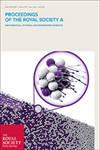晶界扩散蠕变模拟:一些新的数值技术分析
Proceedings of the Royal Society of London. Series A. Mathematical and Physical Sciences
Pub Date : 2004-08-08
DOI:10.1098/rspa.2004.1287
引用次数: 8
摘要
本文考虑用晶界扩散蠕变法模拟多晶材料的变形。对于在节点处相交的给定晶界网络,在适当的边界条件下,我们可以计算材料沿每个晶界溶解或沉积的速率,从而预测每个晶粒为适应这种溶解/沉积而移动的速率。我们讨论了在有限时间间隔内模拟网络变化的两种数值方法,基于在小时间间隔内使用相邻晶界的运动来估计节点的速度。(在典型实验中,第二种方法使我们的求解速度比单纯的前向欧拉方法快100倍。)我们表明,估计节点速度的精度仅取决于计算节点速度的机器的精度,并推断出,对于所有实际目的,缺乏精确的节点速度值并不会降低我们解决方案的质量。最后,我们考虑了问题在各种不同边界条件下的潜在稳定性,并得出结论,我们的方法有可能为了解晶粒尺寸和形状对多晶材料变形的影响提供有用的见解。本文章由计算机程序翻译,如有差异,请以英文原文为准。
Simulation of grain-boundary diffusion creep: analysis of some new numerical techniques
We consider the simulation of deformation of polycrystalline materials by grain–boundary diffusion creep. For a given network of grain boundaries intersecting at nodes, with appropriate boundary conditions, we can calculate the rate at which material will be dissolved or deposited along each grain boundary and hence predict the rate at which each grain will move to accommodate this dissolution/deposition. We discuss two numerical methods for simulating the network changes over a finite time–interval, based on using the movement of adjacent grain boundaries over a small time–interval to estimate the velocities of the nodes. (The second of these methods has enabled us to speed up solution by 100 times in typical experiments compared with a naive forward–Euler approach.) We show that the accuracy with which the node velocities can be estimated is dependent only on the precision of the machine with which they are computed and deduce that, for all practical purposes, the lack of precise node velocity values does not detract from the quality of our solution. Finally, we consider the underlying stability of the problem under various different boundary conditions and conclude that our methods have the potential for providing useful insight into the effect of grain size and shape on deformation in polycrystalline materials.
求助全文
通过发布文献求助,成功后即可免费获取论文全文。
去求助
来源期刊
自引率
0.00%
发文量
0
期刊介绍:
Proceedings A publishes articles across the chemical, computational, Earth, engineering, mathematical, and physical sciences. The articles published are high-quality, original, fundamental articles of interest to a wide range of scientists, and often have long citation half-lives. As well as established disciplines, we encourage emerging and interdisciplinary areas.

 求助内容:
求助内容: 应助结果提醒方式:
应助结果提醒方式:


